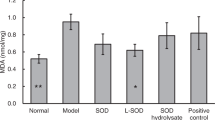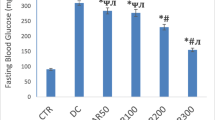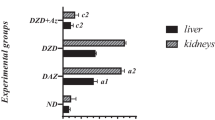Abstract
The present study was designed to evaluate the effect of Vitamin E (Vit. E) on diabetes-induced changes in small intestine, lipid peroxidation and plasma antioxidant capacity in rats. Twenty-four rats were divided into three groups (n=8), namely control, non-treated diabetic (NTD) and Vit. E-treated diabetic (VETD) groups. The VETD group received 300 mg of Vit. E daily in drinking water. After 6 weeks, the length and weight of small intestine, villus height, crypt depth and muscular layer thickness showed a significant increase in the NTD group compared to the control group. In the VETD group, these parameters did not show any significant difference compared to the control group. The level of malondialdehyde (MDA) in the red blood cells showed a signficant increase in the NTD group, but not in the VETD group, compared to the control group. The plasma antioxidant capacity showed a significant increase in VETD compared to the NTD group. These findings indicate that Vit. E significantly improved small intestinal changes in diabetic rats and that these effects could be mediated at least in part by enhanced plasma antioxidant capacity and reduced lipid peroxidation.
Resumen
Se estudia en el presente trabajo el efecto de la vitamina E sobre los cambios debidos a la diabetes en la estructura intestinal, peroxidación lipídica y capacidad antioxidante del plasma en la rata. Se utilizaron 24 animales, divididos en tres grupos (n=8): control, diabéticos no tratados (NTD) y diabéticos tratados con Vit. E (VETD). El grupo VETD recibió 300 mg de Vit. E diariamente en el agua de bebida. Tras 6 semanas, se observó aumento significativo en el grupo NTD de la longitud y peso del intestino delgado, espesor de la capa muscular, altura de las vellosidades y profundidad de las criptas respecto del grupo control. En cambio, en el grupo VETD, esos parámetros no se modificaron significativamente respecto de los controles. De modo similar, el nivel de malondialdehido (MDA) en los eritrocitos aumentó significativamente respecto del control en el grupo NTD y no en el VETD. La capacidad antioxidante del plasma mostró un significativo incremento en el grupo VETD respecto del control y NTD. Estos hechos indican que la vitamina E mejora las alteraciones intestinales debidas a la diabetes y que los efectos podrían estar parcialmente mediados por la disminución de la peroxidación lipídica y el aumento de la capacidad antioxidante del plasma.
Similar content being viewed by others
References
Baynes, J. W. (1991):Diabetes.,40, 405–412.
Benzie, I. F. and Strain, J. J. (1996):Anal. Biochem.,239, 70–76.
Bonnefont-Rousselot, D., Bastard, J.P., Jaudon, M.C. and Delattre, J. (2000):Diabetes Metab.,26, 163–176.
Caballero, B. (1993):Nutr. Rev.,51, 339–340.
Cameron, N.E. and Cotter, M.A. (1999):Diabetes Res. Clin. Pract.,45, 137–146.
Coppey, L.J., Gellett, J.S., Davidson, E.P., Dunlap, J.A., Land, D.D. and Yorek, M.A. (2001):Diabetes,50, 1927–1937.
Ekundayo, A.A., Lee, C.Y. and Gooldlad, R.A. (1995):Gut,36, 203–208.
Feldman, M. and Schiller, L.R. (1983):Ann. Intern. Med.,98, 378–384.
Furlan, M.M., de Miranda, Neto, MH., Santana, Dde M. and Molinari, S.L. (1999):Arq. Neurosiquiatr. 57(3B), 740–745.
Gopaul, N.K., Anggard, E.E., Mallet, A.I., Betteridge, D.J., Wolff, S.P. and Nourooz-Zadeh, J. (1995):FEBS Lett.,368, 225–229.
Halliuell, B. and Gutteridge, J. M. C. (1999): “Free radicals in Biology and Medicine”. Oxford University Press.
Jenkinson, K.M. and Reid, J.J. (1995):Br. J. Pharmacol.,116, 1551–1556.
Jervis, E.L. and Levin, R.J. (1966):Nature,210, 391–393.
Keaney, J.F. and Loscalzo, J. (1999):Circulation,99, 189–191.
Koch, K.L. (1999):Dig. Dis. Sci.,44(6), 61–1075.
Loesch, A., Belai, A., Linconln, J. and Burnstock, G. (1986):Acta Neuropathol.,70, 161–168.
Maleki, D., Locke, GR., Camilleri, M., Zinsmeister, A.R., Yawn, B.P., Leibson, C. and Melton, L.J. (2000):Arch. Intern. Med.,160, 2808–2816.
Miller, D.L., Hanson, W., Schedl, H.P. and Osborne, J.W. (1977):Gastroenterology,73, 1326–1332.
Monekton, G. and Pehowich, E. (1980):Can. J. Neurol. Sci.,7, 135–142.
Nievelstein, P.F., Sixma, J.J., Offenhof-Rovers, M., Wynne, H.J., De Groot, P.G. and Banga, J.D. (1991):Diabetes,40, 1410–1417.
Nouroz-Zadeh, J., Rahimi, A., Tajaddini-Sarmadi, J., Trischler, H., Rosen, P., Halliwell, B. and Betteridge, D.J. (1997):Diabetologia,40, 647–653.
Nowak, T.V., Chey, W.W., Chang, T.M., Weisbruch, J.P. and Fouquet, G. (1995):Dig. Dis. Sci.,40, 828–836.
O’Reilly, D. and Long, R.G. (1987):Dig. Dis.,5, 57–64.
Oberley, L.W. (1988):Free Radical Biol. Med.,5, 113–124.
Rothestein, R.D. (1990):Am. J. Gastroenterol.,85, 782–785.
Samson, M. and Smout, A.J. (1997):Dig. Dis.,15, 263–274.
Shohat, J. and Boner, G. (1993):Isr. J Med. Sci.,29, 228–239.
Stocks, J. and Dormandy, T.L. (1971):Br. J. Haematol.,20, 95–111.
Thulesen, J., Hartmann, B., Nielsen, C., Holst, J.J. and Poulsen, S.S. (1999):Gut,5, 672–678.
Younoszai, M.K., Parekh, V.V. and Hoffman, L. (1993):Proc. Soc. Exp. Biol. Med.,202, 206–211.
Yu, B.P. (1994):Physiol. Rev.,74, 139–162.
Author information
Authors and Affiliations
Corresponding author
Rights and permissions
About this article
Cite this article
Shirpoor, A., Ilkhanizadeh, B., Saadatian, R. et al. Effect of Vitamin E on diabetes-induced changes in small intestine and plasma antioxidant capacity in rat. J. Physiol. Biochem. 62, 171–177 (2006). https://doi.org/10.1007/BF03168466
Received:
Issue Date:
DOI: https://doi.org/10.1007/BF03168466




